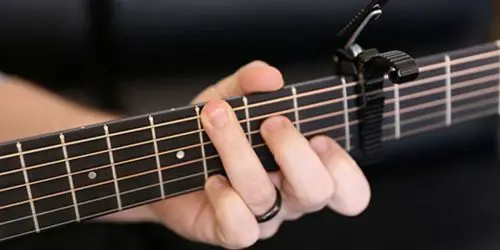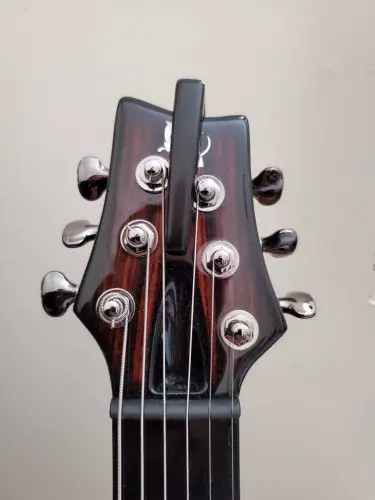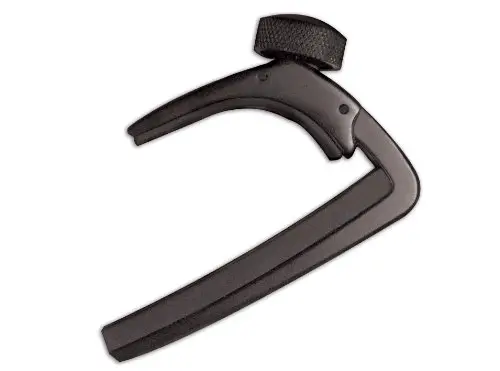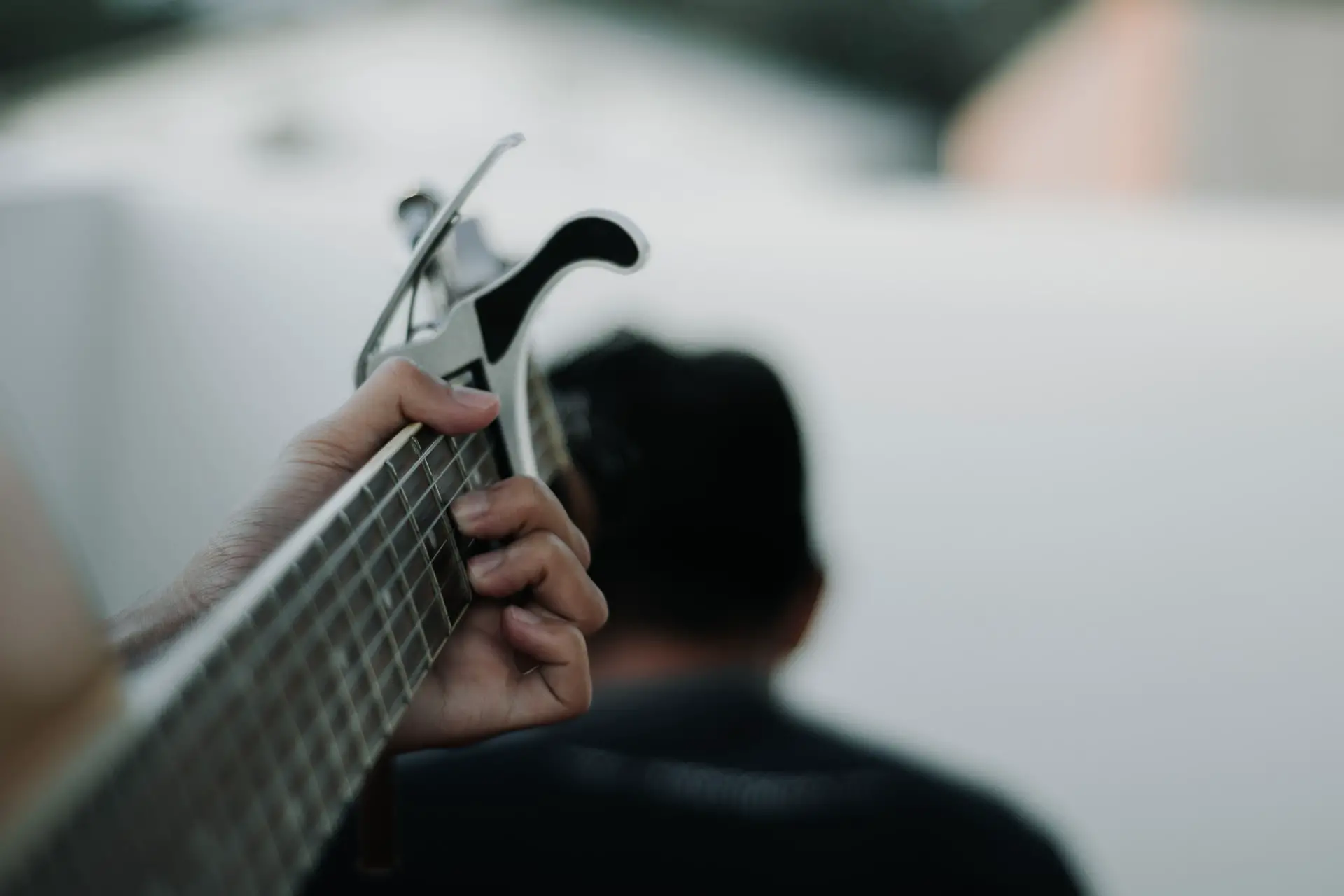Using a capo on a guitar can damage your guitar and also affect the tune/Sound of your acoustic device including an electric guitar – if left on for a significantly long time.
Excessive pressure and over-tighten of the capo can damage your guitar neck and also result in wear out of your guitar fret.
Personally, I have been a victim of this before; my headstock has a permanent stain because I permanently left the capo there.
In this article, I discussed capos and guitar extensively; I believe this article contains all you need to know about capos; this article will cover the following topics
- Can capo Damage my guitar?
- Does leaving a Capo on a guitar mess up the tuning?
- Is it bad to keep capo on the headstock?
- Is it bad to leave your capo on?
- Can a capo damage your guitar strings?
- Can a capo damage my guitar neck?
- Do all types of Capo damage the fret?
- Ways to prevent a capo from damaging your guitar
- Conclusion
Can Capo Damage my Guitar?
Putting a capo on your guitar can damage your guitar fret; leaving a capo in the guitar for a very long time results in wear and tear of the guitar frets and the guitar neck.
In short, leaving a capo in a guitar will damage your guitar and leave some big marks or stains on the guitar; this may reduce the market value of your guitar if you intend to sell the guitar at any time.
Although, with the right capo tension coupled with the proper placement of the capo, you can reduce the level of damage a capo can have on your guitar.
If you must use a capo, I recommend using a variable tension capo; this type of capo prevents your guitar fret from wearing out; after using a capo, develop a habit of unclipping the capo from the guitar immediately.
Leaving a capo on your guitar overnight will lead to wearing out of the guitar fret and the guitar neck.
In summary, a capo can do some damage to your guitar. If you must use a capo, ensure you unclip the capo away from the guitar immediately you are done with the guitar.

A capo that’s too tight can damage the guitar if left on for a long time
Does leaving a Capo on a guitar mess up the tuning?
Using a capo affects the guitar’s sound/tone. Over tightening the capo is unlikely to affect the guitar strings no matter the excess pressure on the guitar. However, the effect of a capo on tuning /sound applies to all acoustic and electric guitars
If you notice that your guitar tone changes after putting a capo on the guitar, it is evident that the capo is the reason for the change.
At this point, you need to check if the capo was placed properly; most times, a lot of people, including me, put the capo on the guitar the wrong way
Always endeavor to check your guitar intonation when you notice that your guitar intonation changes;
The guitar intonation can be affected by a capo; a capo pulls out all the guitar strings; this happens mainly in all acoustic, including the electric guitar.
If you must use a capo, I recommend you use a high-quality capo; a cheap Capo affects your guitar string and can lead to wearing out of the guitar fret; excess pressure from this cheap capo squeezes the guitar string and lifts them out of tune.
I personally recommend getting any of the following high-quality capos:
- Stagg
- Kyser
- G7th
- Hub
- Jim Dunlop
Capo is ideally meant to be placed very close to the fret to prevent damage or wear out. However, it may be possible that you put your capo into your guitar in a hurry without using the required force across the strings.
On a final note, I advise you to regularly change your string to get the best out of your guitar.
Is it bad to keep capo on the headstock?
Leaving a capo on a headstock is not an issue; however, keeping a capo on your guitar headstock is terrible when you are not using the guitar.
Keeping a capo on a headstock can damage the guitar and also leave some big marks on your headstock.
I recommend unclipping a capo after use; developing this habit prevents the capo from leaving some significant stains on your headstock; these stains are likely to affect the market value or the resale value of your guitar if you intend to sell.

I used to leave my capo on the headstock like this. Over time a permanent strain develops.
Is it bad to leave your capo on (all the time)?
Leaving a capo on your guitar will damage your guitar fret, especially when the capo is over-tightened towards the guitar neck.
many professionals have criticized the habit of leaving a capo on your guitar for a long time.
When you leave a capo on your guitar, it damages the fret, wears out the guitar neck, and leaves some significant stains on the guitar; if you must use a capo, ensure you unclip it from your guitar once you are done playing the guitar.
I advise you to inculcate the habit of always unclipping your capo once you are done; keeping your capo on is a nasty habit; aside from damaging the guitar, fret packing your guitar with the capo on can be very difficult.
Overall, the cost of a new guitar fret is currently high. To prevent incurring unnecessary costs, ensure you develop a habit of always unclipping your capo from the guitar immediately after you finish playing the guitar.
Can a capo damage your guitar strings?
A capo can’t damage your guitar strings; this is because the pressure exerted by a capo on a guitar string is not enough to hurt them.
When using a capo, the guitar strings are one thing you should be less worried about; regardless of the pressure from the capo, the pressure can’t damage the strings.
However, I change my guitar strings frequently regardless of any damage because guitar strings are cheap and affordable.
Overall, a capo cannot damage a guitar string no matter the amount of force placed on the guitar by the capo.
Can a capo damage my guitar neck?
A capo can damage a guitar when it is over-tightened. Excess pressure on your guitar from the capo can result in wearing out of the guitar neck,
Applying excess pressure on your guitar can leave some big marks on your guitar; I advise you do not over-tighten your capo when using the guitar in other to increase the lifespan of your guitar neck and also prevent a constant change of your guitar neck
Do all types of Capo damage the fret?
There are different types of capo; however, not all types of capo damage the guitar fret and the guitar neck
There are two standard capos types: variable tension capos and trigger capos.
The most common type of capo is the trigger capo; it has existed for a long time; it is relatively easy to use; however, this capo is not adjustable. Therefore they can either be too loose or tight.
When the trigger is too tight, it leads to wearing out of the guitar neck and fret.
A variable capo is very easy to use; it doesn’t damage your guitar fret if it is not over-tightened to the guitar neck.
Since I bought this type of capo, the changes have been significant; I have experienced no wear and tear of my guitar fret and neck.
Overall, it is advisable to get the variable capo to reduce the rate of wear and tear; however, be very careful not to overtighten the capo in other to avoid the capo leaving some big scratch on your guitar.

Variable tension capo is always recommended.
Ways to prevent a capo from damaging your guitar
Even though a capo can damage your guitar, some methods you can adopt will help prevent your guitar from being damaged by a capo.
1. Use a variable tension capo
Using a variable tension capo helps to reduce the wear and tear of your guitar neck and guitar strings; a variable tension capo also improves the lifespan of your guitar neck and fret.
I recommend using this type of capo; ever since I got the variable tension capo, I have not bought a new guitar fret or replaced my neck. With the help of a variable tension capo, my guitar is always in good shape. The variable tension capo solves all problems you must have been facing when using the fixed capo.
2. Take off your capo after use
Leaving a capo on your guitar after use is a terrible habit; it can wear and tear your guitar fret and guitar neck.
The best way to prevent your guitar from being damaged by a capo is always to take it off when you are not using it; this way, you prevent yourself from incurring some expense of getting a new fret and a neck.
After use, leaving a capo on your guitar can leave some strange marks on your guitar.
However, all this can be prevented by unclipping your capo immediately after use.
3. Improve your Strumming Technique
The harder you strum your guitar, the more the guitar fret wears out; the use of a capo increases the rate at which your guitar fret wears out; your fret wears out faster when using a capo because of the pressure exerted on the guitar by the capo.
If your fret keeps wearing out, you should consider improving your strumming skills; this will help to reduce your guitar sound and the rate at which your guitar wears out.
You can improve your strumming skills in the following ways:
- Don’t strum from the elbow; always strum from the forearm and wrist; while you do this, ensure your elbow is stagnant
- For a start, it is advisable to use a guitar pick; it allows you to strum easily
The best way to learn is by observation; you can improve your strumming skills by watching how professional guitarists do theirs
You can do this by picking a favorite guitarist and watching how they play the guitar; many people developed their strumming skill this way.
When you watch them, ensure you emulate what they do; by doing this, you learn faster and look keenly at how they move their wrist, arms, and hold the guitar.
You can watch this excellent YouTube video that helped me strum on a guitar.
Conclusion
Without a doubt, a capo is a great tool; however it has a lot of disadvantages and shortcomings, a capo can damage your guitar neck and fret if over-tightened.
However, you can still reduce the rate of damage caused by a capo when you unclip the capo from your guitar immediately after you finish playing.
It is essential to cultivate this habit to prevent damage that may likely reduce your guitar’s sales value.
Using the proper strumming technique can also help reduce the level of damage to your fret and neck; it is advisable to use the variable tension capo.
This article has also provided some reasons why capo can affect the tone of your guitar, reasons such as wrong placements, intonation, and low-quality capo.
Hopefully, this little content can help you when your guitar goes out of tune when using a capo.





